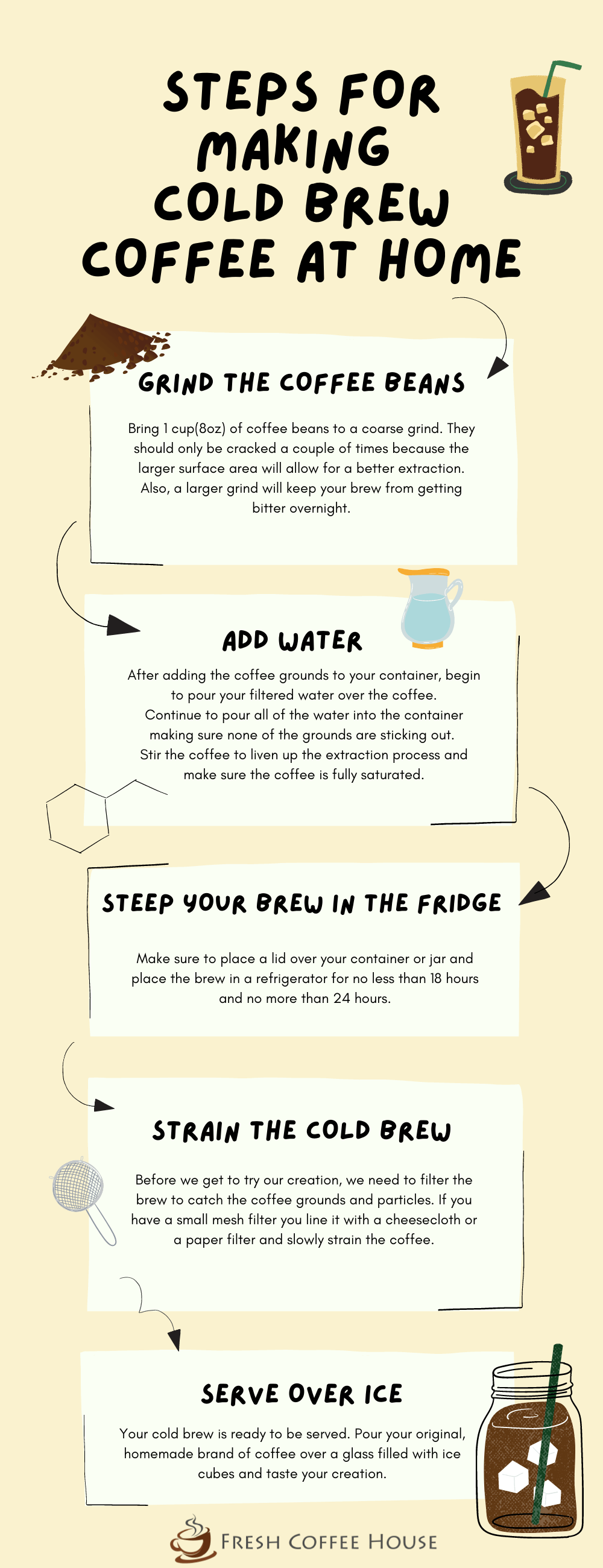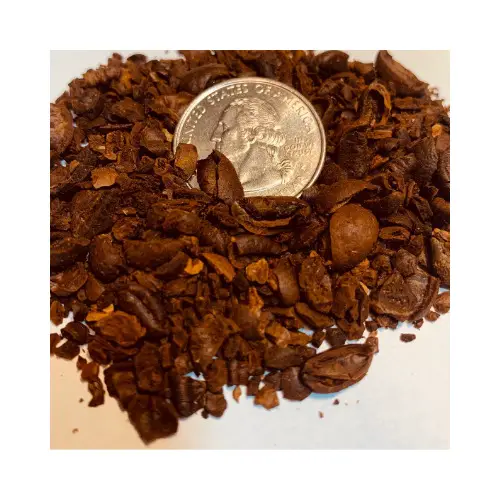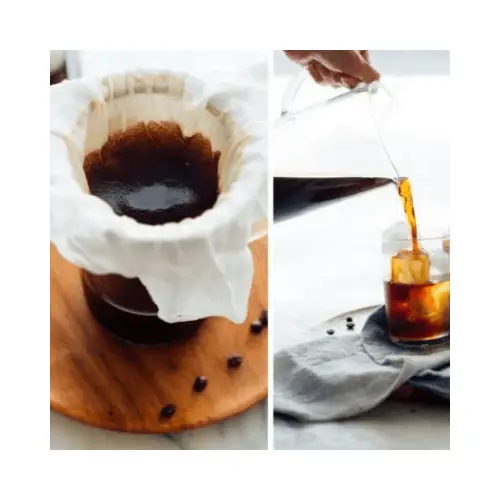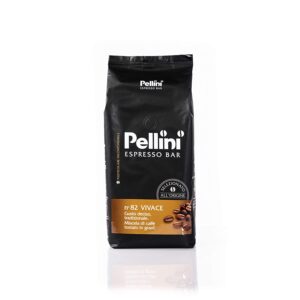Your time to play coffee master is finally here. You can create your own brand of coffee, a secret recipe to pass down from generation to generation. Something to be proud of and to ‘wow’ your friends and company with.
Cold-brew coffee has recently become the talk of the coffee community, but you don’t have to spend big bucks to buy it at your local coffee shop.
Let me show you how to make cold brew coffee at home without any fancy coffee makers or gadgets.

What Is Cold-Brew Coffee?
The name kind of gives away the secret, doesn’t it?
Cold-brew is coffee made with cold or room temperature water. In fact, it’s the only type of coffee drink that never comes in contact with hot water. Cold-brew refers to the process of extracting coffee from the beans. You may be surprised at how simple and easy this process really is.
Expect your cold cup to be a smooth and less bitter coffee compared to what you’d usually get when using the same beans with hot water.
That’s because the coffee bean oils and acids that cause unpleasant flavors are not soluble in cold water, which is a whole other conversation altogether. In simple terms, cold water doesn’t release the same acids from the coffee beans as hot water does. Higher temperatures extract acidic parts of the bean which can irritate your stomach. Did I convince you to try cold-brew yet?

What We Will Need to Make Cold-Brewed Coffee
Here is a quick rundown of the materials we’ll need to brew four 8oz cups of our own brand of coffee right at home.
A Large 1 Liter Jug or Container
The coffee we make will need to sit in a large container for almost a whole day. I suggest using a glass container over a plastic one. Make sure it has a lid so it can stay closed.
1 Liter(34oz) of Filtered Water
Since we’re not using boiled water it’s really important that you use filtered water for this brewing technique. The water you use can make or break your final brew because it makes up 99% of your coffee.
If you know that your tap water is safe to drink, use cold water fresh from the tap. It’s a good habit to let the water run for a few seconds first. Filtered or natural spring water will provide the best-tasting coffee.
1 Cup(8oz) of Fresh Coffee Beans
Feel free to use your favorite coffee beans to make a batch of cold brew. If you’re looking for a suggestion, try Cold Brew Lab.
After spending months experimenting with different coffee beans I can honestly say Cold Brew Lab is second to none when it comes to cold brew coffee beans. Mainly because they are specialists in this type of brewing technique. If you want to know more about Cold Brew Lab take a look at my list of the best coffee beans for cold brew.
Optional Equipment
A Coffee Grinder
You can use any coffee grinder to get the ideal grind for cold-brew. In case you need a refresher on the difference between burr and blade coffee grinders, you can find it here.

Steps for Making Cold Brew at Home
You are ready to become a coffee master and make your own brand of coffee, a news staple of your kitchen, or even a holiday treat. This coffee is easier to make than most other coffee drinks since you don’t need anything other than coffee beans, water, and a jug.
Step 1: Grind the Coffee Beans
Bring 1 cup(8oz) of coffee beans to a coarse grind. They should only be cracked a couple of times because the larger surface area will allow for a better extraction. Also, a larger grind will keep your brew from getting bitter overnight.
Use an automatic grinder for a couple of seconds or a burr grinder on the highest setting possible. If you don’t have a grinder you can wrap the beans in a cloth and crush them with a hammer.

Step 2: Add Water
After adding the coffee grounds to your container, begin to pour your filtered water over the coffee.
Continue to pour all of the water into the container making sure none of the grounds are sticking out.
Stir the coffee to liven up the extraction process and make sure the coffee is fully saturated.
Step 3: Steep Your Brew in the Fridge
Make sure to place a lid over your container or jar and place the brew in a refrigerator for no less than 18 hours and no more than 24 hours. Some people like to drink their brew after just 12 hours. If you want to sneak a cup and taste the brew after a shorter time frame, do so and compare the results to your final drink.
The reason I suggest steeping your coffee for at least 18 hours is that the taste of your brew will be richer and more pronounced. For example, Starbucks steeps each batch for 20 hours.
Step 4: Strain the Cold Brew Concentrate
Before we get to try our creation, we need to filter the brew to catch the coffee grounds and particles.
If you have a small mesh filter you line it with a cheesecloth or a paper filter and slowly strain the coffee.
In some cases, people like to use clean handkerchiefs, old shits, or even socks to strain their coffee. I’m guessing there are quite of few coffee filter substitutes you never knew about.

Step 5: Serve Over Ice
Your cold brew is ready to be served. Pour your original, homemade brand of coffee over a glass filled with ice cubes and taste your creation.
If the cold brew flavor is too bold then pour 1/2 glass of coffee and 1/2 glass of cold water.
Viola, you have your first homemade, original cold brew coffee ready to be served. For better results focus on two main factors. The coffee to water ratio and the extraction time.
Coffee to Water Ratio
The standard for making cold-brew is 4 cups of water for every 1 cup of ground coffee. The more coffee you add to your mix the stronger the taste will be. On the other hand, if you decrease the amount of water you add your cold brew will be a more concentrated type of coffee.
The correct ratio is something you will need to experiment with as you look for that unique taste.
It’s important to remember that during this process each batch you make will have a different taste. Don’t give up on your creation if your first try doesn’t come out the way you wished. You should be prepared to try a few variations of the coffee to water ratio before you settle on a final taste.
Extraction Time
Each batch should steep for no less than 18 hours, but if you are feeling impatient, you can sneak a taste after 12. Just know that a full 18 hours will give your coffee a stronger and more robust flavor.
If you are brewing the coffee at room temperature, strain the drink within 24 hours as steeping for any longer will result in a bitter dusty taste. If you are brewing the coffee in a refrigerator the cold will cause the extraction process to slow down so we suggest steeping for 20 to 24 hours.
What Beans Should I Use?
The best beans for cold brew coffee come from Central America or Africa because they tend to have a more delicate flavor profile. The flavor of the beans used for brewing will be the exact flavor of your final product since the brewing technique uses cold water and a long-brewing process.
I suggest starting your cold-brew journey with Cold Brew Lab, but if you’re inclined to try something different I made a list of all the best coffee beans for cold-brew coffee.
Shelf Life of Cold Brew Coffee
Cold coffee doesn’t necessarily go bad but once it loses its freshness it will taste chalky or even woody. Be sure to finish your cold brew within 7 to 10 days as letting it sit any longer will make the coffee taste a little off. Who can say, you may enjoy aged cold brew coffee.
No one will know unless you try but be aware drinking ten-day-old cold brew coffee is the same as drinking a day-old, reheated cup of joe. It’s still coffee but it doesn’t have the same feel and taste that you’ve grown to expect.
Are Cold-Brew and Iced-Coffee the Same Thing?
The first major difference between these two is the preparation of each drink. Cold-brew, as mentioned before is brewed and served cold, whereas iced coffee is brewed with hot water but served over ice. So, what’s the difference?
Typically, cold brew coffee has more caffeine than iced coffee because of the brewing process but as you may have considered, it’s up to the coffee maker to decide how much coffee they use.
Health Benefits of Cold-Brew Coffee
Cold brew coffee is easy on your stomach. Therefore, it’s favorable for individuals with digestive issues who don’t want to give up their favorite drink. Even though cold brew is stronger than regular coffee it tends to be easier on the digestive system.
When coffee is brewed with hot water it releases acids into the drink. These acids cause coffee-related discomforts such as acid reflux, heartburn, or IBS. Coffee brewed in cold water gives you the full flavor of the bean without any of the unwanted acids. This in large part is the way cold brew coffee has become so popular over the last few years. Individuals are still getting their caffeine fix without the unwater discomforts.
Brewing the coffee with cold water results in lower acidic levels, meaning the coffee won’t cause acid reflux, heartburn, IBS, or other coffee-related discomforts.
Summary
Now you know everything you need to make your personal brand of cold brew coffee. The only thing left to do is start brewing!
Related Questions
Can You Heat Up Cold Brew and Drink it Hot?
Yes, you can heat up your cold-brewed coffee and enjoy it as a hot beverage. Expect the drink to have a really bold and authentic coffee flavor with very low acidity.
Does Cold Brew Have More Caffeine than Hot Coffee?
Since the ratio of coffee to water is greater in cold brew than what we typically use in regular coffee machines, then yes, cold brew coffee has more caffeine than regular coffee.
I’ve always seen coffee as a way of bringing people together. Everywhere I go people seem to enjoy a fresh cup of coffee and that’s what drives my passion. There’s always a new brew to master, and there’s always a new face to enjoy it with. Hitch a ride with me on a coffee-fueled adventure to find a perfect cup.


